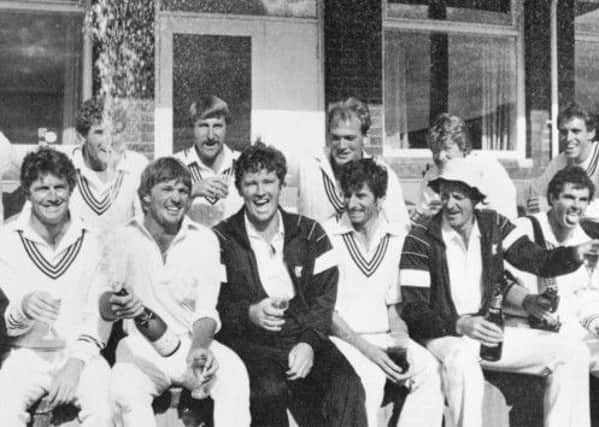Half-century ‘of sweat and toil’ earned its reward at Headingley


It was a historic moment.
After 52 years, and at the 29th attempt, New Zealand had beaten England in a Test match in England.
“For that victory,” proclaimed Wisden, “the tenth New Zealand side to England will hold a lasting place in its country’s cricket history.”
That side comprised a raft of recognisable names.
Advertisement
Hide AdAdvertisement
Hide AdThere was John Wright and Bruce Edgar, the left-handed opening batsmen; Geoff Howarth, the captain; Martin Crowe, the side’s leading batsman, along with Crowe’s elder brother, Jeff, a fine run-maker in his own right and now an International Cricket Council match referee.
Coney – today that refreshing rarity of an articulate player-turned-pundit – was a splendid all-rounder and Richard Hadlee a man who requires introduction only to cricketing philistines.
The history-making XI was completed by off-spinner John Bracewell, wicketkeeper Ian Smith and pace bowlers Lance Cairns and Ewen Chatfield, the latter having almost died on his Test debut against England at Auckland in 1975, when he was struck on the head by a ball from England’s Peter Lever and swallowed his tongue.
New Zealand’s build-up to the 1983 Leeds Test, however, had been anything but smooth.
Advertisement
Hide AdAdvertisement
Hide AdThe Kiwis had failed to pull up trees in the Prudential World Cup, which preceded the Test series, and they lost the opening Test at The Oval by 189 runs.
After England had scored 209 in their first innings, Derek Randall leading the way with an unbeaten 75, and Hadlee returning figures of 6-53, New Zealand made 196 in reply as Hadlee registered 84.
Chris Tavare, Graeme Fowler and Allan Lamb each struck centuries in England’s second innings 446-6 declared before New Zealand were routed for 270, Vic Marks and Phil Edmonds each capturing three wickets.
It was a somewhat chastened Kiwi side, therefore, that pitched up at Leeds for the second game of a four-match series, one they would ultimately lose 3-1 as England won by 127 runs at Lord’s and 165 runs at Trent Bridge.
Advertisement
Hide AdAdvertisement
Hide AdHowever, signs that the tourists’ luck was in at Headingley came at the toss.
Howarth won it and, on a pitch that started damp, Cairns, in particular, and the bowling group in general exploited conditions to dismiss the home side for 225, Tavare top-scoring with 69 and Lamb contributing 58.
“In Cairns and Chatfield,” commented Wisden, “New Zealand had two (bowlers) whose speed was better suited to conditions than their faster England rivals.
“By bowling a full length, they also gave the ball a better chance to swing.”
Advertisement
Hide AdAdvertisement
Hide AdCairns, 33, returned 7-74 from 33.2 overs, Coney chipping in with two wickets and Chatfield one, with Hadlee going wicketless.
“But no miscarriage of justice would have been required for Hadlee to emerge with comparable figures,” insisted the almanack.
“Accurate and businesslike off his spry clipped run, he beat the bat innumerable times. His control was exceptional and, generated by a high arm and strong body action, his pace sufficient.”
Edgar was injured early on in the New Zealand first innings when he was struck on the hip by a ball from Botham.
Advertisement
Hide AdAdvertisement
Hide AdHe returned to hit a brave 84, Wright posting 93 and Hadlee a precious 75 from the No 7 position that helped the Kiwis to a lead of 152.
David Gower compiled a superb, unbeaten 112 in the second innings but received no support as England were ejected for 252.
Chatfield returned 5-95 from 29 overs and Cairns 3-70 from 24 overs to give him 10 for the match, while Coney prised out the key wickets of Lamb and Botham.
Left to score 101, New Zealand stuttered in the finest traditions of Headingley suspense.
Advertisement
Hide AdAdvertisement
Hide AdBob Willis, the England captain, ripped out four wickets to reduce them to 61-4, charging down the slope at the same Kirkstall Lane end from which he took 8-43 in the famous victory against Australia in 1981.
Willis claimed his fifth victim – his 300th in Tests – when he bowled Jeff Crowe with the score on 83 en route to match figures of 9-92, his best in Test cricket.
But Coney kept his cool in a challenging situation to steer New Zealand to what was also their first overseas Test win since 1969.
“Later,” reported Wisden, “asked what was in his mind as Willis imperilled what had looked a fairly simple victory, Coney modestly tipped his cap to history by saying, ‘The main feeling was thinking of all the New Zealand players who have been coming here for 52 years, better players than myself, and making sure that their sweat and effort had not been in vain’.”
It was a classy remark from a classy cricketer – and one that set the seal on a famous win.